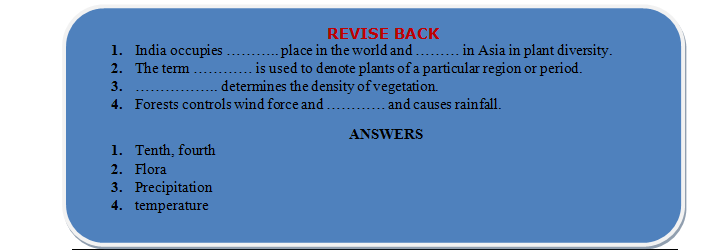
Importance forests our life
Forests Our Lifeline of Class 7
A forest is a biotic community spread over a large tract of land and composed predominantly of trees, shrubs and woody climbers, and often with a closed canopy.The science of development and management of the forests is called forestry. Officer incharge of forests is called forester.
Importance forests our life
Forests are the invaluable wealth of a country, and a renewable natural resource. They are beneficial to man in several ways like
- Fuel Wood : The heaviest demand on forests is for fuel wood in the developing countries. Over 1,500 million people use wood as a source of energy for cooking and keeping warm.
- Timber : Timber is the basic material for building houses. It is also used for making furniture, railway sleepers, and compartments, buses, trucks, carts, boats, ships, docks, bridges, sports goods, poles, mine props, ploughs, tool handles, matches and toys. Wood is a raw material in the manufacture of films.l Paper : Newsprint, high quality book paper, stationery, packing paper, sanitary paper and many other kinds of paper are produced from wood and bamboo pulp.
- Bamboos : Bamboos form the poor man’s timber. They are used in rafters, scaffolding, roofing, walling, flooring, matting of rayon (artificial silk and other fibres or yarns).
- Rayon : Bamboo and wood are used as a raw material for the manufacture of rayon (artificial silk and other fibres or yarns).
- Canes : Canes are the solid stems of slender palms. They are used for making furniture, walking sticks, umbrellas handles, sports goods, instruments of punishment and ropes. They are also used as a planting material.
- Forest Products : Forests provide a large number of important products, such as essential oils, natural camphor, tannins, resins, gums, drugs, species, poisons, insecticides, soap substitutes, bidi wrappers, ornamental seed rudraksha, cork from Quercussuber, and distillation products. Lac, silk, honey and cochineal are obtained from the forest insects. Horns, hides, musk and ivory are provided by forest mammals.
- Food : Forest tribes take tubers, roots, leaves and fruits of plants. They also take meat of forest animals.
- Oxygen : Forests, along with other vegetation, help maintain oxygen content of the atmosphere for man and other animals to breathe.
- Shelter : Forests provide shelter and food to a variety of plants (mosses, ferns), animals (insects, reptiles, birds, mammals) and microorganisms.
-
Protection of Environment
: Forests protect the environment by preventing soil erosion. This is achieved in four different ways like
- a. The network of plant roots firmly binds the soil.
- b. The leaves reduce the force of the rain drops to keep soil intact.
- c. The trees decrease the velocity of the wind to prevent dislodging of soil particles.
- d. The shade of trees keeps the soil cool and moist in summer to offset the eroding effect of the wind.
- Improvement of Soil : Dead fallen leaves of the trees decay and form human that increases the porosity and fertility of the soil.
- Control of Climate : Forests increase the atmospheric humidity by transpiration (loss of water as vapour through stomata). The increased humidity affects rainfall and makes the air cool in summer for the survival of the plants and animals.
- Reduction of Atmospheric Pollution : Forests reduce atmospheric pollution by using carbon dioxide and by collecting suspended particulate matter on their leaves.
Forests Area in India
India had abundant forests in ancient times. Ashoka’s stone edicts prescribed tree planting. Increase in population, lack of foresight and indiscriminate felling have greatly reduced the forests.
According to the Central Forestry Commission (1980), forests in India covered about 75 million hectares. This area formed about 23% of the total land area. The ‘‘state of the forest report 1991’’ showed only 19.49% of land area under forests in India. However, remote sensing surveys have shown that it is only 14%.As per the India’s national forest policy, 33% of the total land area should be under forests. Hence, our achievement in the past 55 years of independence is far below expectation.









